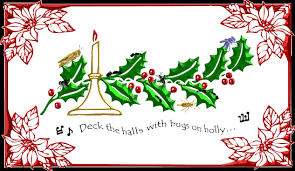Quiz—What popular British Christmas
favorite is actually a Welsh New Year’s carol in disguise? Hint—it is one of the festive
street caroling songs and also celebrates a pagan-ish Yule without
any mention of Christmas or the Christ Child. Answer—Deck the Halls!
Blind Welsh Harpist John Parry first noted the melody for Nos Galan in a 1741 manuscript.
The melody
for the song comes from a Welsh winter or New Year’s carol probably
dating to the 17th Century or earlier and first found in manuscript by
Welsh harpist John Parry as Nos
Galan (New Year’s Eve),
in 1741 and published in Musical
and Poetical Relicks of the Welsh Bards by Edward Jones in 1784.
The English words to Nos Galan began as follows:
Oh! how soft my fair one’s bosom,
fal lal lal lal lal lal lal lal
la.
Oh! how sweet the grove in
blossom,
fal lal lal lal lal lal lal lal
la.
Oh! how blessed are the blisses,
[instrumental flourish]
Words of love, and mutual kisses,
fal lal lal lal lal lal lal lal la.
That titillating
lyric was representative of the revelry associated with New
Year’s. Additional Welsh lyrics added
later and translated literally without attempt to rhyme included
reference to drinking:
The best pleasure on new year’s
eve,
fal lal lal lal lal lal lal lal
la.
Is house and fire and a pleasant
family,
fal lal lal lal lal lal lal lal
la.
A pure heart and brown ale,
fal lal lal lal lal lal lal lal
la.
A gentle song and the voice of the
harp
fal lal lal lal lal lal lal lal
la.
The
English lyrics were written by the Scottish musician Thomas Oliphant and
first appeared in 1862, in Volume 2 of Welsh Melodies, a set of four volumes by John
Thomas, and named Deck the Hall. Note the singular form which
referred to the common custom in Celtic societies like Wales, Scotland,
and Brittany in France of decorating homes for New Year’s visiting
and parties.
Thomas’s
collection included Welsh words by John
Jones (Talhaiarn) which were once regarded as the source for
Oliphant. It was actually the other
way around—Jones translated Oliphant’s version into Welsh.
Oliphant’s
song continued reference to drinking in the first verse and mentioned
Christmas. FYI—troul in the first verse means a round or lively folk
song.
Deck the hall with boughs of
holly,
Fa, la, la, la, la, la, la, la,
la!
'Tis the season to be jolly,
Fa, la, la, la, la, la, la, la,
la!
Fill the meadcup, drain the
barrel,
Fa, la, la, la, la, la, la, la!
Troul the ancient Christmas carol,
Fa, la, la, la, la, la, la, la!
See the flowing bowl before us,
Fa, la, la, la, la, la, la, la,
la!
Strike the harp and join the
chorus.
Fa, la, la, la, la, la, la, la,
la!
Follow me in merry measure,
Fa, la, la, la, la, la, la, la!
While I sing of beauty's treasure,
Fa, la, la, la, la, la, la, la,
la!
Fast away the old year passes,
Fa, la, la, la, la, la, la, la,
la!
Hail the new, ye lads and lasses!
Fa, la, la, la, la, la, la, la,
la!
Laughing, quaffing all together,
Fa, la, la, la, la, la, la, la!
Heedless of the wind and weather,
Fa, la, la, la, la, la, la, la,
la!
An American
version of the lyrics published in the Pennsylvania
School Journal in 1877 removed references to drinking replacing “Fill
the meadcup…” with “Don we now our gay apparel”, “See the flowing bowl…” with
“See the blazing Yule before Us”, and “Laughing, quaffing all together” with “Sing
we joyous all together.” It also
replaced “ancient Christmas carol” with “ancient Yuletide carol.” These are the lyrics usually sung in the United
States.
The title
was not pluralized to Deck the Halls until
1892.
The song
was perfect for street caroling, parlor sing-alongs, and in public
school holiday programs which could be skittish about religious
carols. It is also popular with neo
pagans who sometimes seem to believe that the 19th Century English
words are much more ancient and perhaps even pre-Christian.
Deck the Halls has been recorded many times. Nat King Cole had a charted hit with
his version and it launched the jazz/syntho-pop/New Age
instrumentalists Mannheim Steamroller as an annual Holiday Season touring
phenomenon in 1984.
Today’s
version is from Nat King Cole’s 1960 Capitol Records LP The Magic of Christmas which was later re-mastered for stereo
and issued as The Christmas
Song three years later. It was
the best-selling Christmas album of the 1960s, and was certified
by the RIAA for shipments of 6 million copies in the U.S. The 1963 version reached #1 on Billboard’s Christmas Albums chart
and remained for two weeks. The song was
included in several compilation records, was featured on Cole’s holiday
TV specials and remains a perennial Christmas radio favorite.




No comments:
Post a Comment